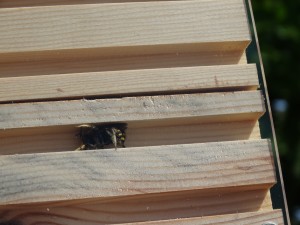First ever wool carder bees in garden and nest boxes!
The wool carder bee, (Anthidium manicatum), arriving in my wildlife garden absolutely took me by surprise. It was the first time I had noticed them. I was even more surprised when I found several females sleeping in my nest boxes! Unusually for solitary bees, the females emerge before the males and are smaller. Usually, there are more males and they tend to disappear before the females. Not so with this species. I saw one and then many more females nectaring over the weekend on Common toadflax, French lavender, Bowles Mauve (a top wildlife plant!) and later Bird’s foot trefoil. The males unusually for solitary bees arrive after the females. Most males were all about the same size, then later in the weekend a couple of huge, magnificent males beasts arrived and started to make their presence felt.
The wasp-like and colourful males are extremely fast living bees, flying from flower to follower, feeding, chasing, fighting. I could see a gradual pattern emerging after many hours watching and filming, over the weekend, (another video shortly!). Goodness knows where they came from but I’m sure glad they did!
I have no Lamb’s ear (Stachys byzantina) in my garden, a favourite for females to chew hairs from plant stems and leaves for the wool-like fibres and ‘card’ them, rolling them into a ball and then used to line the nest. This plant is now on my wildlife gardening “hit list”, a non neonic one of course!
BWARS states that ” Favoured plants are woundworts (Stachys lanata [s. byzantina]), yarrow (Achillea millefolium), great mullein (Verbascum thapsus), Pelargonium, cotton thistle (Onopordum acanthium) and house-leek (Sempervivum). Hairs are brought to the nest site in a ball and applied to the inner surface of the cavity by teasing them out with the mandibles”.
Download a BWARS Information Sheet about wool carder bees
For info and link to buy an excellent book Field Guide to the Bees of Great Britain and Ireland by Steven Falk
An extremely useful resource supports this book by a special web site feature within Steve Falk’s Flickr web site which furnishes extra photos and other useful resources to assist with identification.
Interested in Citizen Science and pollinators? The Buzz Club


Recent Comments